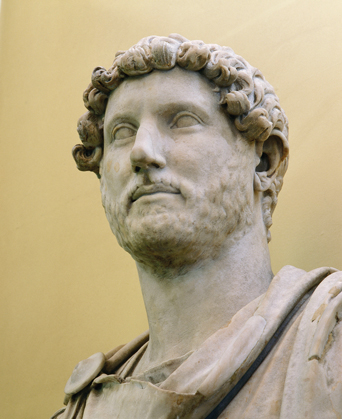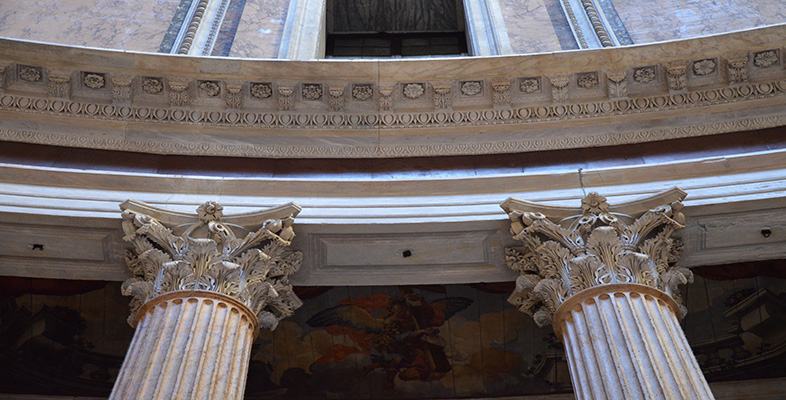1 Introducing Hadrian
The aim of this section is to find out a little more about Hadrian and the major sources of evidence for his reign.

Activity 1
Begin by establishing some basic information about Hadrian. Use the internet and other reference resources that may be available to you. Remember to be mindful of the nature of the information that you use and evaluate its reliability.
Hadrian was a much-travelled emperor, so for the purposes of this exercise you may wish to focus your information gathering on how Hadrian came to power and the time he spent in Rome.
Don’t spend too long on this activity. An hour should be sufficient.
Discussion
We’re not going to rehearse the major events of the reign of Hadrian. The information you found out will depend on the resources you used.
It is interesting to note that Hadrian came to power as the adopted son of the emperor Trajan, of whom he was a distant relative. You may have picked up on rumours that Trajan’s wife (Plotina) might have played as much a part in this adoption as Trajan did. As the nominated successor to Trajan, Hadrian was part of a continuing dynasty; he did not seize power or gain it during civil war. In his turn, Hadrian too was at pains to secure the succession, ensuring that he had a suitable adopted son in place at his own death, thereby securing both the continuation of the dynasty and peace and stability for Rome and the empire.
We have already observed that, as emperor, Hadrian travelled the empire and was often away from Rome. You may have discovered that he was a particular fan of Greek culture and he was sometimes called the ‘little Greek’ (SHA, Hadrian 1). Hadrian was also a prolific builder, in both Rome and the empire, funding numerous constructions of varied kinds. You may have observed, too, that Hadrian has a bit of a mixed reputation – he appears to have been an able administrator, a military man and someone who was genuinely interested in the provinces, but in Rome itself he seems to have been unpopular, especially on account of executing some of his opponents.
We do not have extensive literary accounts of Hadrian’s reign. Suetonius (who was writing during that reign) ended his imperial biographies with Domitian. Tacitus and Pliny the Younger were both dead before Hadrian came to power. Dio Cassius’ account of Hadrian’s reign does survive, but only in abridged form. We also have a biography of Hadrian, but it is not without problems.
Activity 2
Read the following information on the Scriptores Historiae Augustae or SHA (also sometimes referred to as the Historia Augusta) and Dio Cassius.
Scriptores Historiae Augustae: The SHA is a collection of biographies of Roman emperors and some of their heirs, covering the years 117–284 CE. The text is incomplete and authorship is uncertain, but it purports to be the work of more than one hand, a group of authors known as the Scriptores Historiae Augustae. However, arguments have now been made that the SHA is the work of just one author. It remains unclear exactly when this author(s) was writing, or the purposes behind the work. The sources of information used by the author to compile the biographies are often uncertain, and there are doubts about the authenticity of some of the documents that are referred to.
Dio Cassius: Dio Cassius wrote, in Greek, an 80 book history of Rome from its foundation to 229 CE. He was writing during the late second and early third century CE, and was a distinguished senator, whose family came from Bithynia in Asia Minor. Dio Cassius lived through some troubled times and tyrannical emperors. His history of Rome is now incomplete, and the book which covers Hadrian (Book 69) is a summary produced by a later author (Xiphilinus). Dio Cassius would have been dependent on earlier written sources for his history of Hadrian, but the nature of these is not known.
Then read the following:
- Primary Source 1: SHA, Hadrian 9; 11; 13; 19; 21; 27. (Note that the entire text is reproduced, but for this activity you need to read only the chapters specified. You will read more of this source later in the course.)
- Primary Source 2: Dio Cassius 69, 2.5; 69.4–5.2; 69.7, 1–4; 69.23.
What strikes you about how these sources are written (for example their style and content)? How reliable do you think they are?
Discussion
What strikes us about the extracts from the SHA is that they are often like lists: lists of provinces that Hadrian visited and lists of buildings that he restored, with little by way of detail or expansion. In other places the material also seems disorganised. For example, in Chapter 21 the author talks about judges, freed slaves and slaves, then provides an anecdote about something Hadrian once said about a slave, before mentioning what Hadrian best liked to eat.
The extracts from Dio Cassius can also lack detail and contain anecdotes (such as Hadrian’s killing of Apollodorus). What is striking is that Dio Cassius tries to weigh up some good and bad aspects of Hadrian’s reign, ultimately noting that although in many respects Hadrian did a good job, he was still disliked; the emperor had a mild disposition, but also a murderous one. All this may suggest that the sources Dio Cassius used to write his own account may have presented mixed views of the emperor. It also suggests that Dio Cassius himself was not writing objective history; rather, his perspective was influenced by his own social position, as a member of the Senate, who had experienced life under some terrible rulers. To Dio Cassius, ‘mild’ Hadrian was not as bad as some other emperors.
Neither source would be regarded as completely reliable if judged by the standards expected of modern historians, that is to be objective, impartial and balanced. However, ancient authors did not adhere to such codes, and often saw history and biography as having important moralising and didactic elements
The extracts that you were asked to read from the SHA and Dio Cassius are just that: extracts, smaller parts of a larger whole. Here the aim was to give you a flavour of these works and the issues surrounding them.
The SHA is a problematic source. It is late in date, of uncertain authorship, of uncertain readership and at times can be inaccurate and muddled. On the plus side, the life of Hadrian is viewed as one of the more reliable of these biographies (Birley, 1976, p. 13) and it does contain a certain amount of factual information that can be checked against other sources, including Dio Cassius. The latter’s account of Hadrian’s reign, as we have seen, is also short on detail, and is coloured by the author’s own perspectives. Taken together, however, these works do give us a narrative structure for Hadrian’s rule, which we can complement with other evidence such as monuments, coins and inscriptions. And it is on this evidence that much of this course will focus.
